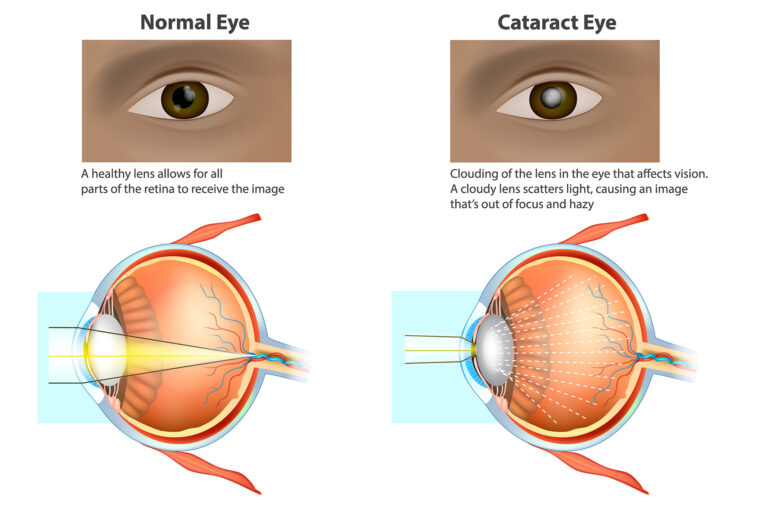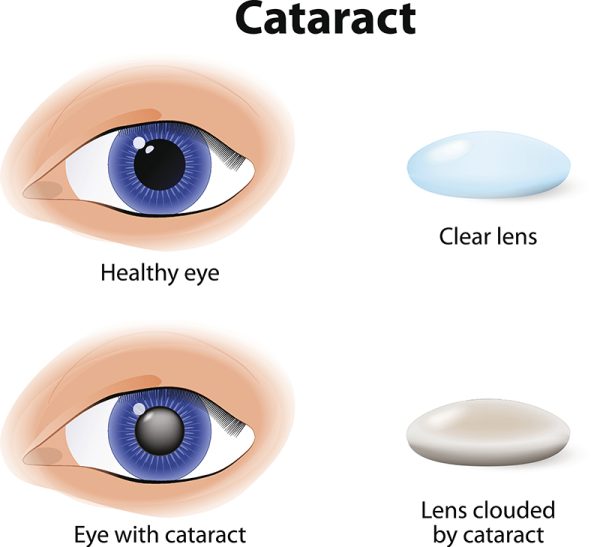
What is a Cataract?
Thanks to modern cataract surgery, it is never necessary to wait until a cataract is “ripe.” In fact, it is best to remove the cataract once it begins to cause trouble with your eyesight. Here at Hawaiian Eye Center, we offer a range of personalized cataract treatments and surgery to restore clear vision.
We want all of our patients to be able to make smart decisions when it comes to picking the right cataract treatment and the best cataract surgeon for your needs. If you have a question about cataracts, you may give us a call at one of our locations or refer to our page on eye conditions for more in depth information on cataracts.
What are the Cataract Symptoms?
The main symptom of cataracts is blurry vision, and it can feel as though you are looking through a cloudy window. Other symptoms include increased sensitivity to light, seeing halos and excessive glare from light sources, trouble seeing contrast between colors, and monocular double vision (seeing double in one eye). Early symptoms include seeing glare and haloes while driving at night and difficulty reading, even with your glasses. As a cataract develops, these symptoms may worsen and if left untreated, may lead to legal or even total blindness.
What Causes a Cataract?
Though there are multiple causes of cataracts, most occur as we age. Because they are a normal part of the aging process, everyone will eventually develop cataracts. Eye injuries can also be a cause of cataracts.
Heredity and lifestyle are another factor that play a major role in the development of cataracts. Smoking and prolonged UV light exposure without proper protection from the sun can cause early progression of cataracts. Some medical conditions and the medicines used to treat them are also causes of cataracts. Diabetics are more likely to develop cataracts.
Though there is not much you can do to prevent cataracts from forming, researchers recommend quitting smoking, using proper eye wear or hats while in the sun, and taking supplements containing modest doses of Vitamin C, Vitamin E, Omega 3 Fatty Acids, and Lutein.
When should a cataract be removed and how will you know?
Cataract symptoms can range from minor vision disturbances to severe vision loss, and even in the earlier stages, these symptoms can have a strong effect on your normal activities and lifestyle.
For instance, common symptoms of the earlier stages of cataract formation are the increased glare and reduced contrast. This can make driving difficult due to sunlight in the daytime or the brightness of oncoming car headlights at night. This can potentially become very dangerous for both the driver as well as other drivers and pedestrians.
Because cataracts develop gradually, the early stages are typically not noticeable. However, some signs you may look out for are difficulty reading, seeing the television or digital screens, or recognizing faces, as these are common as cataracts progress. If you are unsure about any changes to your eyesight, we suggest scheduling and maintaining regular eye exams to have a professional diagnose any eye conditions, establish the right treatment plan, and prescribe proper eye wear as needed.
It is important to note that while it usually does no harm to the eye to leave a cataract alone, it does mean vision will worsen with time. Worsening vision increases the risk of injuries due to falls and automobile accidents. Waiting too long to remove the cataract can also make the surgery more difficult for the surgeon, increasing the risk of complications during surgery. Because of this, we advise that cataracts be diagnosed and removed when vision becomes blurred or quality of life is affected.



